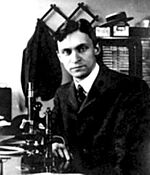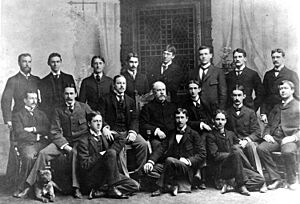Eugene Lindsay Opie facts for kids
Quick facts for kids
Eugene Lindsay Opie
|
|
|---|---|

Eugene Lindsay Opie, in 1903
|
|
| Born | July 5, 1873 Staunton, Virginia, U.S.
|
| Died | March 12, 1971 (age 97) Bryn Mawr, Pennsylvania, U.S.
|
| Alma mater | Johns Hopkins University |
| Known for | Research on diabetes mellitus and tuberculosis |
| Scientific career | |
| Fields | Medicine, Pathology |
| Institutions | Johns Hopkins University Rockefeller Institute Washington University in St. Louis Cornell University University of Pennsylvania |
| Doctoral advisor | William H. Welch |
Eugene Lindsay Opie (born July 5, 1873 – died March 12, 1971) was an important American doctor and scientist. He studied how diseases like tuberculosis spread and how to diagnose them. He also worked on ways to protect people from these illnesses. Dr. Opie taught as a professor of pathology (the study of diseases) at several medical schools. He even served as the leader, or Dean, of the Washington University School of Medicine in St. Louis, Missouri.
Contents
Early Life and Education
Eugene Opie was born in Staunton, Virginia, on July 5, 1873. His father, Thomas, was a doctor who helped deliver babies and cared for women. Thomas Opie also helped start the University of Maryland College of Medicine.
Eugene went to Johns Hopkins University for both his first degree and medical school. He earned his first degree in 1893. Then, in 1897, he was part of the very first group to graduate from the Johns Hopkins School of Medicine.
While studying, Opie worked with a famous pathologist named William H. Welch. Opie became very interested in studying body tissues to understand diseases. As a medical student, he noticed important changes in the pancreas of people with diabetes mellitus. This discovery helped scientists understand how diabetes develops.
After medical school, Opie continued his training with Dr. Welch. He kept studying diseases of the pancreas. He found a link between blockages in a part of the pancreas called the ampulla of Vater (often caused by gallstones) and a serious condition called acute pancreatitis.
In 1904, Opie moved to New York City. He began working at the Rockefeller Institute. There, he focused on how certain parts of white blood cells (called leukocytes) cause inflammation in the body. He also worked as a pathologist at Columbia-Presbyterian Hospital. He became an editor for important scientific journals like the Journal of Experimental Medicine.
Leading at Washington University
In 1910, Dr. Opie became the head of the pathology department at Washington University School of Medicine (WUSM) in St. Louis. From 1912 to 1915, he was the dean of the school. During his time as dean, he helped the school grow a lot. He expanded its buildings, scientific goals, and what students learned.
Serving in World War I
When the United States joined World War I, Opie took a break from his work at WUSM. He joined the U.S. Army as a colonel in the Medical Corps. He served in France, focusing on infectious diseases and how to prevent them among soldiers. During this time, he gathered new information about influenza, tuberculosis, and "trench fever" (a disease called bartonellosis). After the war, Opie returned to Washington University and continued his work until 1923.
Important Research on Tuberculosis
Dr. Opie became very focused on tuberculosis, which was a widespread and dangerous disease in the early 1900s. In 1923, he became the director of the Phipps Institute. This institute, located at the University of Pennsylvania in Philadelphia, was dedicated to studying and treating tuberculosis. He also became a Professor of Pathology there.
Over the next ten years, Opie's work taught scientists a lot about how children and adults get tuberculosis. He also learned about how the body's immune system fights the disease. In 1932, Opie moved to Cornell University Medical Center in New York to continue his research. As the head of the Pathology department there, he brought in many talented young pathologists. These scientists, like Robert A. Moore and Jules Freund, later became famous researchers themselves.
Later Years and Honors
Opie officially retired from full-time work in 1941. However, he didn't stop his scientific studies. For the next 28 years, he worked as a "guest investigator" at the Rockefeller Institute. He continued to publish scientific papers until 1970. Besides infections, Opie also studied liver carcinogenesis (the start of cancer), changes in nucleic acids in diseases, and how fluids move in tissues.
Dr. Opie received many honors for his important work. He was the president of several major scientific groups, including the American Association of Pathologists and Bacteriologists and the National Tuberculosis Association. He received special honorary doctorates from Yale University, Rockefeller University, and Washington University. He also won several prestigious awards, such as the 1959 Jessie Stevenson Kovalenko Medal and the 1960 Academy Medal for Distinguished Contributions in Biomedical Science.
Personal Life
Eugene Opie married Gertrude Lovat Simpson on August 6, 1902. They had four children: Thomas Lindsay, Anne Lovat, Helen Lovat, and Gertrude Eugenie. After Gertrude passed away in 1909, he married her sister, Margaret Lovat Simpson, on September 16, 1916.
Death
Eugene Lindsay Opie passed away at Bryn Mawr Hospital in Bryn Mawr, Pennsylvania, on March 12, 1971. He was 97 years old.
See also


